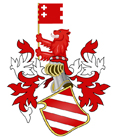Kukanj
Kukanj Fortress was built at the beginning of the 15th century as a border and customs town of the Serbian family Kosaca. The fortress was built by the Serbian duke Sandalj Hranic Kosaca. It was built in the area of the town of Pljevlja in the area of Breznica in Polimlje. It is located on the bank of the river Cehotina, on the steep eastern side, which descends sharply towards the river.
Name: Kukanj
Location: Pljevlja (Montenegro)
Purpose: Border and customs control
Year of construction: 1420
Builders: Kosaca family (Serbian duke Sandalj Hranic Kosaca)
Year of destruction: 1465
Kukanj Fortress was built at the beginning of the 15th century as part of the defense system of the Principality of Herzegovina. It was built by the Serbian duke Sandalj Hranic Kosaca in 1420. He often stayed in it and christened it as a summer residence. The duke was of a curious spirit and very energetic, so he often personally visited his fortified cities. In the Kukanj fortress, he often met with Dubrovnik emissaries, concluding agreements.
In 1422, it is mentioned in Dubrovnik historical documents as the summer residence of the Kosaca family. The documents mention the Serbian duke Sandalj Hranic Kosaca and the fortress as his summer residence. Kukanj Fortress had its own suburb called Podkukanj. There lived the inhabitants of the city, the army, the farmers who supplied the fortification with food and supplies.
02/19/1444 year in the charter of the Aragonese-Neapolitan king Alfonso V, Kukanj is mentioned as one of the cities belonging to the Kosaca family under the rule of the Duke of St. Sava Stefan Vukcic Kosaca. It lists his estates and the cities he rules. It is a question of recognition of the state of the Knezevina of Herzegovina.
Cochangu in Brisiniza castello con lo contato
01/20/1448 In the charter of the Roman king Frederick III, Kukanj is also mentioned as one of the cities ruled by the Kosaca family headed by the duke. The question is the recognition of the independence of the Principality of Herzegovina by Rome. According to that charter, the Kukanj fortress was part of the Knezevina of Herzegovina.
Castrum Gukani
In 1452, in the second charter of the king of Aragon, Alfos, it is mentioned as one of the cities ruled by the Kosaca family, headed by the Duke of St. Sava, Stefan Vukcic Kosaca. Confirmation of the statehood of the Knezevina of Herzegovina because those were very troubled times and the borders changed very often.
Civitate Cochangu Euchane cum castris et pertinentiis suis
In 1465, with the conquest of the fortified city by the Turkish conquerors, it was destroyed. After that, it was never rebuilt and since then its function as a fortified city ceases.
DOCUMENTATION:
